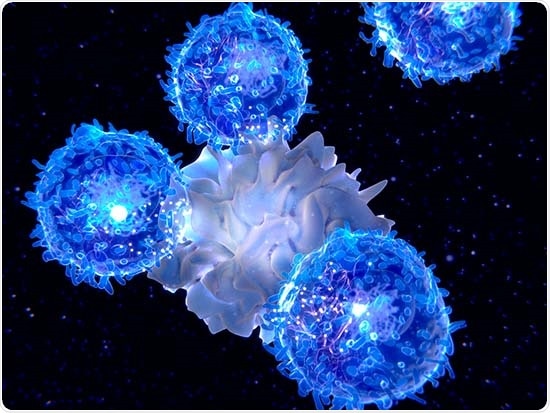The immune system is a complicated network of cells and proteins that performs a straightforward function—protecting the body against infection. To do so, viruses or bacteria that infect the body, must be recognized and destroyed by the cells. Furthermore, the system must maintain track of each pathogen it has destroyed to immediately remobilize if it becomes infected again.

In response to a viral infection, intrinsic IL-2 production by effector CD8 T cells affects IL-2 signaling, leading to different fates for two subsets of those cells—the one producing IL-2 and the one not producing IL-2. Image Credit: University of Alabama at Birmingham
According to a new study published in the journal Science Immunology, two subsets of one kind of immune cell, the CD8 T cell, grow to give either short-term or long-term immune protection. The study focuses on interleukin-2, or IL-2, as a factor that directs the developmental bifurcation.
Understanding how naive immune cells grow into efficient infection-fighters or long-lived memory cells is crucial as it can help researchers figure out which components of a complicated response are required to guard against infections or malignancies. It can also help researchers better understand immune system malfunction and enhance cancer immunotherapy.
Autoimmune illnesses, in which the immune system targets the body’s own cells, and fatigue, in which the immune system loses its ability to combat infection or eradicate malignancy, are examples of immune system malfunctions.
Allan Zajac PhD, and co-first authors Shannon M. Kahan PhD, and Rakesh K. Bakshi PhD, researchers from the Department of Microbiology at the University of Alabama at Birmingham, used mouse models to track the traits and fates of the two subsets of CD8 T cells beginning at the peak of their effector phase, eight days after an acute viral infection.
CD8 T cells are white blood cells that can grow into effector T cells, often known as cytotoxic T cells or killer T cells. These cells can kill cancerous cells as well as cells infected with viruses or bacteria. IL-2 is a cytokine, which is a tiny signaling protein secreted by cells to relay instructions to other cells or to function as an autocrine signal to the cell that produces the cytokine.
The cytokine attaches to a receptor on the cell surface, and the signal is received by cell. The signal is sent to the cell interior, causing changes in gene expression and phenotype.
At the climax of the effector phase, Zajac and colleagues at UAB were able to identify and purify CD8 T cells from mice. Researchers found two subgroups of this group using fluorescence-activated cell sorting following cell stimulation with a viral antigen: a minority of CD8 T cells that generated IL-2 and a majority that did not.
In terms of developmental changes that lead to fate choices, the two subcategories turn out to be dramatically different in the near run. They do, however, grow increasingly similar after a few months.
The IL-2-producing cells grew into immunological memory cells. They developed stem-like memory properties, were resistant to depletion, and imparted protective immunity preferentially in response to a secondary viral assault.
Surprisingly, they did not respond to their own IL-2, which operates inside the cell via the STAT5 complex, or signal transducer and activator of transcription. Despite the fact that the IL-2-producing CD8 T cells exhibited normal levels of IL-2 receptor proteins on the cell surface, the quantity of phosphorylated-STAT5 inside the cell—the active version of STAT5—was significantly reduced.
The researchers suggested that numerous internal cell processes may be at work to reduce the capacity to receive IL-2-dependent STAT5 signals, but the answer is yet unknown.
The non-IL-2-producing effector cells, unlike the IL-2-producing cells, did respond to IL-2 signals and obtained effector features at the price of memory development.
The UAB researchers sequenced the RNA of cell subsets during the effector phase, which began nine days after infection, and the memory phase, which began roughly ten months later. The IL-2-producing and IL-2-non-producing effector populations had distinct transcriptional patterns that could be identified from their memory equivalents.
However, by the memory time point, the two groups’ gene expression had become more similar. The IL-2-producing and nonproducing CD8 T cells appeared to converge as memory evolved, forming populations with equivalent recall capacity to respond to a second viral infection or chronic viral exposure, while having unique features during the effector phase.
This bifurcation between the ability of IL-2-producing and -nonproducing CD8 T cells to respond to IL-2 couples’ functional competency with fate decisions, and it implicates IL-2 as a critical differentiation factor.”
Allan Zajac, Study Senior Author, Department of Microbiology, University of Alabama at Birmingham
The study’s key findings are yet to be confirmed in humans, and they are restricted to investigating CD8 T cell responses to a single pathogen, stated Zajac.
Source:
Journal reference:
Kahan, S. M., et al. (2022) Intrinsic IL-2 production by effector CD8 T cells affects IL-2 signaling and promotes fate decisions, stemness, and protection. Science Immunology. doi.org/10.1126/sciimmunol.abl6322.